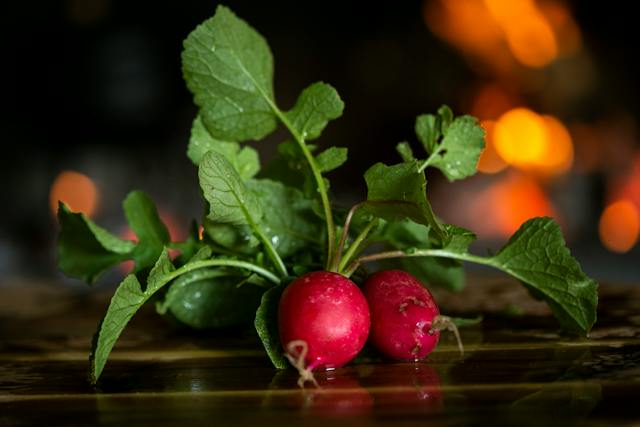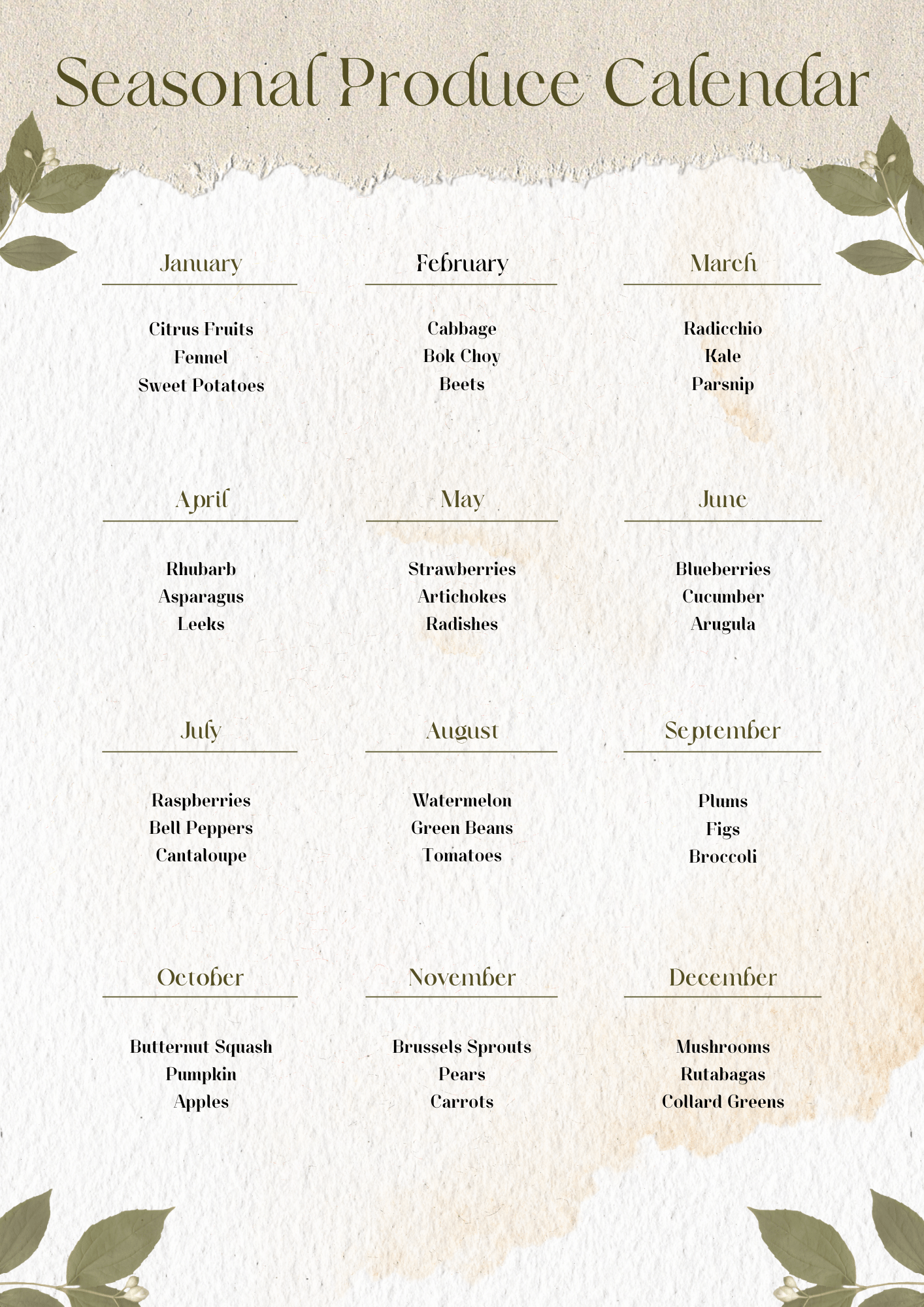Table of Contents
As we begin to feel comfortable with writing this new year’s numerals, planning can shift from reactionary to fun — especially when it comes to looking at seasonal foods. Though our grocery stores pack the same variety of foods throughout the year, seasonal foods are freshest and as a result, contain more nutrients. Eating locally also provides a sustainable, relational aspect to choosing food — making a trip to the local farmer’s market more fun and beneficial to your community. And, it can be made easier by using a tool to guide you to the seasonal produce offerings.
READ MORE >> Variety Is the Spice of Life… and Your Diet
Worried about the cost? Sometimes farmer’s markets can reflect quality in higher pricing; however, seasonal foods tend to be more abundant and can often be on sale (depending on your location).
Worried about the time it’ll take to plan? We’ve put a list together for you, so the hardest work is over— taking you one step closer to fresher, delicious foods each month.
What All Fruits and Vegetables Have In Common
Most of the fruits and vegetables discussed below all share two main nutrients: antioxidants (often in the form of vitamin C) and fiber. These nutrients are especially important year-round, as they support the immune system and our digestive tract.
Antioxidants help neutralize free radicals and prevent further oxidative stress — protecting from both seasonal and chronic illnesses. Vitamin C particularly aids in iron absorption in the gut.
When consumed with the skin, most contain both soluble and insoluble fiber. These are indigestible. As it stays in the digestive tract, fiber ferments with the help of gut bacteria to create short-chain fatty acids. These compounds provide fuel to the intestinal lining, making it strong against permeability common to leaky gut and other GI issues.
January: Citrus Goodness
- Citrus fruits
- Fennel
- Sweet potatoes
As the cold of winter settles into your bones, what happens to be readily found in nature contains nutrients to keep your immune system at peak performance and your skin elastic and smooth amidst any dryness.
All three contain a healthy dose of vitamin C. Sweet potatoes contain an additional antioxidant beta carotene, which the body converts to Vitamin A. Metabolism and blood sugar regulator manganese resides in both fennel and sweet potatoes.
Consider combining these complementary foods, or highlighting each on their own:
February: Beet It
Cabbage and Bok choy contain vitamin K1, which supports healthy blood clotting and wound care. Both cabbage and beets share a purple hue and its corresponding antioxidant called anthocyanins. Some nurses found that those who consumed the highest amount of anthocyanins have a 32% lower risk of heart attack than those who consumed a low amount of the antioxidant.
Beets contain dietary nitrates, which can improve the efficiency of the powerhouse of our cells: mitochondria. One study indicates that consuming beets 2-3 hours before training can boost athletic performance and improve brain function by increasing blood flow to the brain.
Each of these foods contain unique flavor combinations that can enhance dishes or star on their own:
March: Bring on the Roughage
A food commonly used in Mediterranean and Italian cooking, radicchio is more related to dandelions than it is to cabbage. Yet, it shares vitamin K1 with kale and fiber with parsnips.
Kale contains sulforaphane, which can lead to blocking the process of forming cancer cells, according to research.
All three can play a delectable role in Italian and Mediterranean cooking — making them safe to experiment with. Here are some options to consider:
April: Here Comes the Green
Though it resembles celery, rhubarb has a much sourer taste and often requires an added sweetener to foster peak enjoyment. Like asparagus and leeks, rhubarb contains a high level of antioxidants. Rhubarb contains higher levels of calcium oxalate — which contributes to forming kidney stones — when harvested past late June.
Asparagus contains high levels of insoluble fiber, aiding in digestion. Leeks contain allicin, a sulfur compound that has antimicrobial qualities.
Delicious as sides, pies or soups, these foods are surprisingly versatile:
May: Blushing Produce

- Strawberries
- Artichokes
- Radishes
Strawberries rival bell peppers and citrus fruits with their high levels of vitamin C. Some people can be allergic to these sweets, especially if they are also sensitive to birch pollen and apples. Many attribute the allergy to its high level of the antioxidant anthocyanins. The colorless strawberry mutant may not provoke the same allergic reactions as their blushing counterparts.
Artichokes contain inulin, a prebiotic fiber that provides nutrients for the proliferation of health-promoting bacteria in the gut.
Radishes contain the protein RsAFP2 that acts as an antifungal effective in decreasing the amount of Candida albicans in the body.
Though they may not commonly pair in recipes, there are many ways to prepare these nutritious foods:
June: Cool Runnings
- Blueberries
- Cucumber
- Arugula
In the hot summer months, it is no coincidence that seasonal produce for this time includes naturally hydrating and cooling foods. Blueberries contain some of the highest amounts of antioxidants of any food — particularly anthocyanins. This can act as an anti-inflammatory, helping to calm systematic and chronic inflammation.
Cucumber naturally hydrates since it is mostly made of water. Yet it also contains fiber, which can aid in having regular bowel movements.
Peppery green arugula is packed with vitamins and minerals — including calcium, folate, potassium, and vitamins C, K1, and beta carotene.
All three pair nicely for a cool summer salad and offer their unique flavor profile in other dishes. Here are some options:
July: Berry Hot
- Raspberries
- Bell Peppers
- Cantaloupe
Part of the rose family, raspberries are high in many types of antioxidants. One they contain, sanguine H-6, can help kill over 40% of ovarian cancer cells in its concentrated form. Consult a doctor if choosing to use it for that purpose.
Peppers contain the antioxidant lutein which can support eye health. Both cantaloupe and peppers contain beta-carotene. The body converts this to Vitamin A, which can also aid in eyesight by supporting our light-detecting receptors as well as supporting healthy blood clotting and cell growth in reproduction.
Cantaloupe has higher water content and the mineral potassium — both aid in hydration during another hot summer month.
Consider enjoying these nutritious foods in these dishes:
August: Hydration with a Crunch
- Watermelon
- Green Beans
- Tomatoes
Though watermelon simply serves as nature’s treat, it can also help prevent UV damage from the sun. Studies suggest that the antioxidant lycopene found in watermelon can do just that. It might be wise to still wear sunscreen, but you will get some extra support when eating this type of melon.
Interestingly, tomatoes also contain lycopene as well as beta-carotene, chlorogenic acid, and naringenin — all powerful anti-inflammatory compounds. Salsa, anyone?
Green beans contain a trace amount of protein (about 2 grams in a single serving), calcium, and fiber.
Tomatoes and green beans are a classic duo, while watermelon can have some surprising appearance in sweet and savory dishes. We’ll let you choose:
September: Food to Remember
When applied to skin for those with dermatitis, dried fig extract was more effective in decreasing symptoms than hydrocortisone cream in one study. Both figs and plums contain high amounts of fiber. Plums contain sorbitol, a sugar alcohol that has natural laxative properties. Though they are higher in natural sugar, plums also contain compounds that can increase the hormone adiponectin, which aids in blood sugar regulation.
Packed with antioxidants, broccoli contains sulforaphane, which can help decrease cancer. It also contains folate, K1, potassium, manganese, and iron.
These foods are great compliments on a charcuterie board or on their own. Consider these recipes:
October: Sweet with Squash

- Butternut Squash
- Pumpkin
- Apples
True to their hue, butternut squash and pumpkin contain beta-carotene and many other carotenoids. Pumpkin contains a combination of carotenoids lutein and zeaxanthin, which can lower the risk of cataracts and macular degeneration.
All three contain high levels of fiber. Apples have pectin, a type of soluble fiber that can help bulk stools and bind substances in the intestines for a clean exit.
These fall favorites complement each other in flavor and color — making them easy to experiment with in both sweet and savory dishes:
November: More Than Brussels
- Brussels Sprouts
- Pears
- Carrots
What used to be the feared, smelly cruciferous is a hit among foodies! It’s a worthwhile trend, since Brussels sprouts also contain powerful nutrients such as antioxidants, vitamin K1, and fiber.
Like apples, pears contain pectin and antioxidants.
Carrots contain many subsets of carotenoids, thanks to their bright orange color. They also contains biotin, which aids in fat and protein metabolism, and vitamin B6 for energy production.
Check out these warming recipes to snuggle up as the weather begins to cool down:
December: Earthy Treasures
- Mushrooms
- Rutabagas
- Collard Greens
Collard greens and rutabagas happen to come from the same cruciferous family of vegetables. Both contain calcium, which can aid in bone health, while rutabaga is heavier on magnesium.
All three vegetables contain antioxidants. Mushrooms contain antioxidant selenium which aids in reproduction, thyroid hormones, protection from infections and DNA synthesis.
Want to give these earthy treasures a try? Here are some preparation options to consider:

As you look into the year, there are so many more nutrient-dense fruits and vegetables in season that aren’t listed above. Seasonal produce can vary by location, so the best way to verify what is in season is by stopping by your local farmer’s market or looking at the local produce section in your grocery store. Take this seasonal produce guide as a starting point, knowing that there are endless possibilities with the wealth and diversity our soil brings.
Ready to Dive Deeper into Nutrition? The Nutrition Therapist Master Program Will Take You There!
If this seasonal produce guide has ignited your passion for nutrition and well-being, take the next step towards a fulfilling career. Enroll in our Nutrition Therapist Master Certification program and embark on a journey of knowledge, empowerment, and transformation.
Enroll Now: Try out a course with our Single Course Enrollment option!
Have questions? Contact our admissions team at [email protected] or by calling 303-284-8361 for personalized assistance.
About the author: Lisa (Driscoll) Lopes is a certified Nutrition Therapist Master through NTI’s Nutrition Therapist Master Program. Having studied journalism and vocal performance in undergrad, she enjoys using her voice to share the benefits of living a holistic, integrated lifestyle in writing. You can find more of her writing in the Baltimore Sun, Classical Singer Magazine, Capital News Service, and FOCUS blog.
Image Sources:
- Photo by Kamaji Ogino
- Photo by Wendy van Zyl
- Photo by Karolina Grabowska
- Infographic by Lisa Lopes





More Stories
United Healthcare’s ransomware attack shows why supply chains are under siege
Nutrition Tips For Ramadan | JM Nutrition
Probiotics for IBS | The Nutritionist Reviews